
# 3448 - 2000 34c Flag Over Farm, non-denominated (Ashton Potter)
34¢ Flag Over Farm
City: Washington, DC
Printed by: Sterling Sommer for Ashton-Potter (USA) Ltd
Printing Method: Lithographed
Perforations: 11 ¼
Color: Multicolored
The Rural Electrification Administration
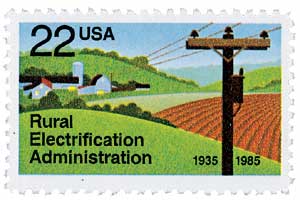
On May 11, 1935, President Franklin Roosevelt signed legislation establishing the Rural Electrification Administration (REA).
After America’s electric industry took off in the 1880s, electricity began to become widespread in cities. Around 1910, city homes and businesses were getting electricity in large numbers. Meanwhile, only one farm in ten had electricity.
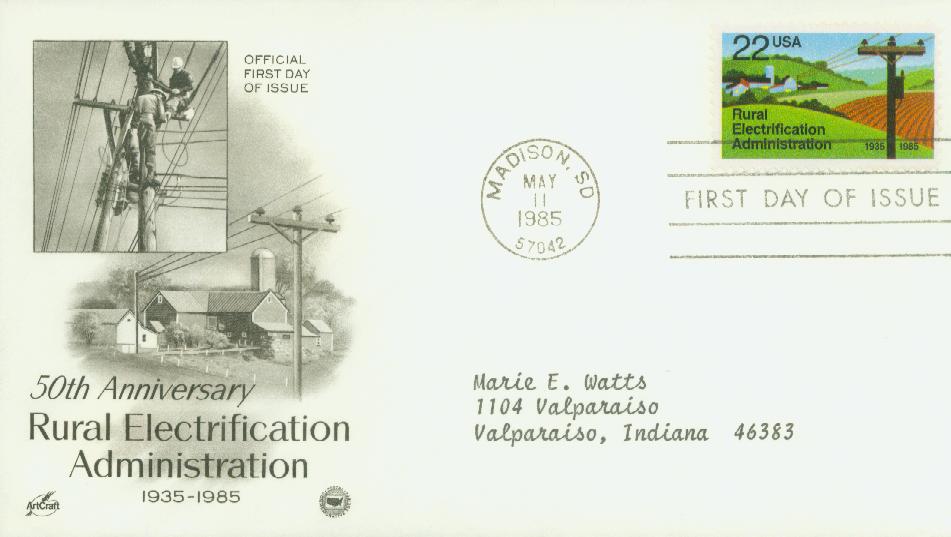
At the time, electrical service providers didn’t want to bother connecting rural areas because the construction costs were higher and profits would be lower with fewer customers spread across larger areas. As the suppliers saw it, these homes were too far apart and didn’t create enough demand to warrant their investment. Plus, by the 1920s, the few rural areas that did receive service paid electrical rates that were twice as much as those paid in urban areas.
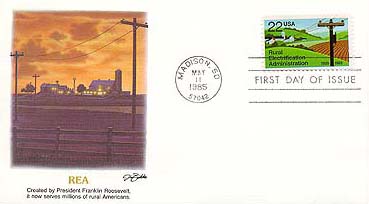
In the 1920s and 30s, more than 30 state rural power programs were started, especially after president Herbert Hoover claimed that rural electrification was the responsibility of state governments. As governor of New York, Franklin Roosevelt pushed for rural electrification and created the New York Power Authority in 1931, which sought to provide inexpensive hydroelectric power from the St. Lawrence River. However, the Great Depression shut down many state power companies and further discouraged investors from rural electrification.
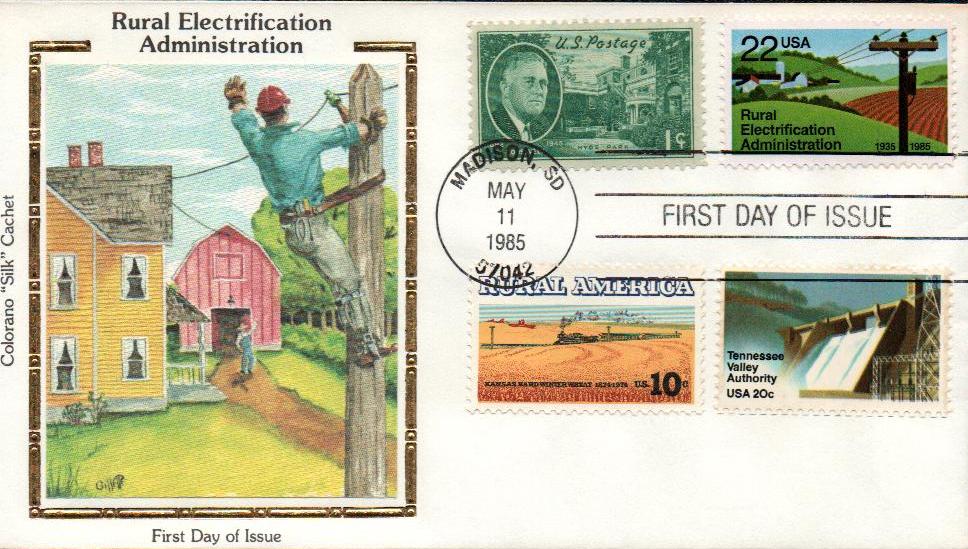
After he became president in 1933, Roosevelt tasked Morris L. Cooke with finding a solution to the rural electrification issue on a national level. Cooke had led a power company in Pennsylvania with great success. By 1934, Cooke produced an 11-page report outlining the needs of a federal rural electrification program. By Cooke’s estimate, it would take $200 million to bring electrical service to the 500,000 rural farms, a cost of $400 per farm.
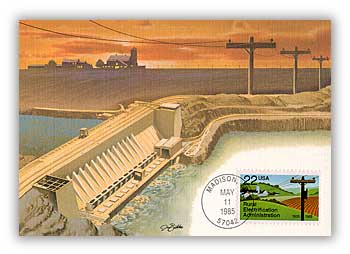
Cooke concluded that a rural electrification agency should be created. Roosevelt agreed and on May 11, 1935, signed Executive Order 7037, creating the Rural Electrification Administration. The following year, Congress authorized $410 million for the REA for a 10-year program to provide electricity to America’s farms. The REA was a government-financing agency that provided loans to private companies with good interest rates.
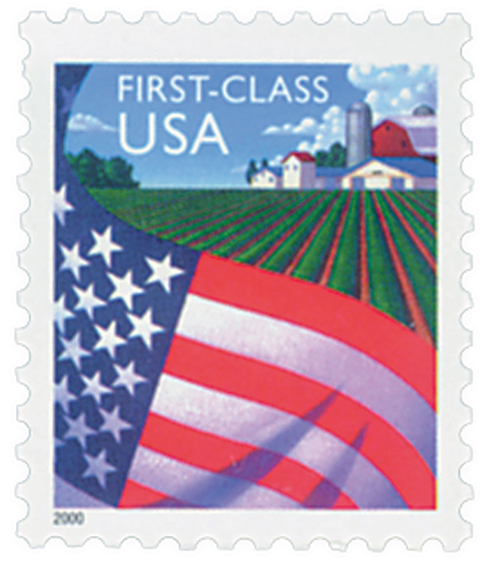
The REA was a major success – after just two years, it had created 350 projects in 45 states delivering power to 1.5 million people. By the mid-1950s, nearly all American farms had electricity. Additionally, as these farms now had electricity, their demands for household electrical appliances helped create major growth in the home appliance market. It also introduced electrical and plumbing trades to rural communities. Soon radios and eventually televisions were introduced to farms, narrowing the divide between rural and urban communities.
In 1949, the REA extended its programs to include telephone service. And in 1994, the REA was absorbed into the new Rural Utilities Service, an agency within the USDA.
34¢ Flag Over Farm
City: Washington, DC
Printed by: Sterling Sommer for Ashton-Potter (USA) Ltd
Printing Method: Lithographed
Perforations: 11 ¼
Color: Multicolored
The Rural Electrification Administration

On May 11, 1935, President Franklin Roosevelt signed legislation establishing the Rural Electrification Administration (REA).
After America’s electric industry took off in the 1880s, electricity began to become widespread in cities. Around 1910, city homes and businesses were getting electricity in large numbers. Meanwhile, only one farm in ten had electricity.

At the time, electrical service providers didn’t want to bother connecting rural areas because the construction costs were higher and profits would be lower with fewer customers spread across larger areas. As the suppliers saw it, these homes were too far apart and didn’t create enough demand to warrant their investment. Plus, by the 1920s, the few rural areas that did receive service paid electrical rates that were twice as much as those paid in urban areas.

In the 1920s and 30s, more than 30 state rural power programs were started, especially after president Herbert Hoover claimed that rural electrification was the responsibility of state governments. As governor of New York, Franklin Roosevelt pushed for rural electrification and created the New York Power Authority in 1931, which sought to provide inexpensive hydroelectric power from the St. Lawrence River. However, the Great Depression shut down many state power companies and further discouraged investors from rural electrification.

After he became president in 1933, Roosevelt tasked Morris L. Cooke with finding a solution to the rural electrification issue on a national level. Cooke had led a power company in Pennsylvania with great success. By 1934, Cooke produced an 11-page report outlining the needs of a federal rural electrification program. By Cooke’s estimate, it would take $200 million to bring electrical service to the 500,000 rural farms, a cost of $400 per farm.

Cooke concluded that a rural electrification agency should be created. Roosevelt agreed and on May 11, 1935, signed Executive Order 7037, creating the Rural Electrification Administration. The following year, Congress authorized $410 million for the REA for a 10-year program to provide electricity to America’s farms. The REA was a government-financing agency that provided loans to private companies with good interest rates.

The REA was a major success – after just two years, it had created 350 projects in 45 states delivering power to 1.5 million people. By the mid-1950s, nearly all American farms had electricity. Additionally, as these farms now had electricity, their demands for household electrical appliances helped create major growth in the home appliance market. It also introduced electrical and plumbing trades to rural communities. Soon radios and eventually televisions were introduced to farms, narrowing the divide between rural and urban communities.
In 1949, the REA extended its programs to include telephone service. And in 1994, the REA was absorbed into the new Rural Utilities Service, an agency within the USDA.
















